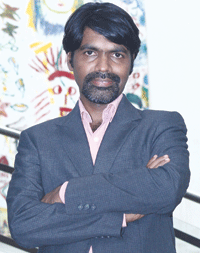“Government education expenditure must rise to 6-8 percent of GDP”
Dilip Thakore interviewed Satya Narayanan R. (popularly known as Satya), founder-chairman of CL Educate Ltd in the company’s head office in Greater Noida. Excerpts.
 What were the motivations and objectives which prompted you to promote Career Launcher as a one-man tutorials firm in 1995?
What were the motivations and objectives which prompted you to promote Career Launcher as a one-man tutorials firm in 1995?
After landing what everyone considered a dream job in Ranbaxy after graduating from IIM-Bangalore, I soon discovered that I preferred to set my own agenda — that I could do much more, much faster than was expected of me in the company. Moreover from my young days I always had an interest in teaching and interacting with youngsters. And realising that I had little to lose except the Rs.4,000 I invested in Career Launcher and could always land a job if the venture failed, I launched Career Launcher.
From test prep CLE has ventured into k-12 and vocational and business education. What was the strategic thinking behind these diversifications?
Test prep was the only business I could afford in 1995. It was a poor man’s choice. After we made a success of Career Launcher and had pioneered 150 bricks-n-mortar learning centres countrywide under the owned and franchised model, we felt the time was right to replicate the model in the school education segment. Our owned schools serve as a model for like-minded franchisees who are appointed after a battery of tests and rigorous evaluation to protect the CLE brand. Similarly, the diversifications into vocational education and business management education were driven by the belief that we must become market leaders in whatever business we enter.
How satisfied are you with the progress of CL Educate’s Indus World School (IWS) chain? What is their distinguishing characteristic?
One of the great achievements is that IWS is already ranked among the country’s best employers. In an annual survey, Great Places to Work, an American research company ranked IWS among the world’s Top 50 — and the only education institution — in terms of employee satisfaction. The distinguishing feature of IWS is that right from the primary years, we start preparing children not for board exams of the next decade, but for life’s challenges as we see them in the era 2030-2070. Our overarching objective is to prepare children for the future by teaching them the skill of learning voluntarily and continuously. To this end, we have developed our 21st century curriculums — Ananda to create love of learning in preschool; Jigyasa to encourage the spirit of enquiry and questioning in middle school; and Sadhana in high school to begin preparing and counseling students for careers of the future. That’s the distinguishing characteristic of IWS.
How serious is CLE’s diversification into vocational education and training (VET)?
Very serious because it’s an urgent national imperative and a massive opportunity as well. The Central government has belatedly set a target of 550 million children and youth countrywide receiving formal VET, and has made generous allocations for achieving this goal. CLE entered this business in 2010 and currently, we are providing VET to almost 17,000 youth in close cooperation with five state governments and have guaranteed them employment. Value added VET which we provide has laid a sound foundation for this business and won us considerable goodwill in government and society.
But CLE’s diversifications into preschool and b-school education failed. What’s your comment?
It’s not quite correct to say these diversifications have failed. Both of them are conceptually sound and went back to the drawing board. The Ananda bricks-n-mortar preschools initiative has been transformed into our Ananda preschool curriculum which will be delivered in all Indus World Schools. Therefore, we have tweaked, rather than abandoned our diversification into preschool education. Similarly, the Indus World School of Business initiative is suspended, not abandoned and is under re-evaluation.
What’s your assessment of the Union government’s Right to Education Act, 2009 and its reform initiatives in higher education?
The RTE Act is well intentioned. But it hasn’t been well thought-out and has obviously been hastily drafted resulting in implementation unclarity.
Perhaps the most glaring defect of the Act is that its school education reform provisions aren’t applicable to 80 percent of the country’s schools, i.e government primary and secondary schools. In higher education, a glaring lacuna is the lack of understanding of the vital role played by community colleges which offer short-term career and vocational education programmes to youth and adults intent upon improving their skills and qualifications periodically. This is the missing element in higher education.
Looking ahead, how optimistic — if at all — are you about the development of K-12 and tertiary education in India to OECD or even South-east Asia standards?
The fact that India is a democracy which allows parents to choose the type of education they deem best for their children, and the reality that at the atomic family level quality education is highly valued, is cause for optimism. On the other hand, poor political leadership and the wrong priorities of leaders of all political parties is cause for pessimism. The greatest failure of independent India’s national development effort is that government — Centre plus states — provision for education has fallen far short of 6 percent of GDP recommended by the Kothari Commission in 1966. If India has to catch up educationally with the rest of the world, annual government expenditure on education has to rise to 6-8 percent of GDP for the next 25 years.














Add comment